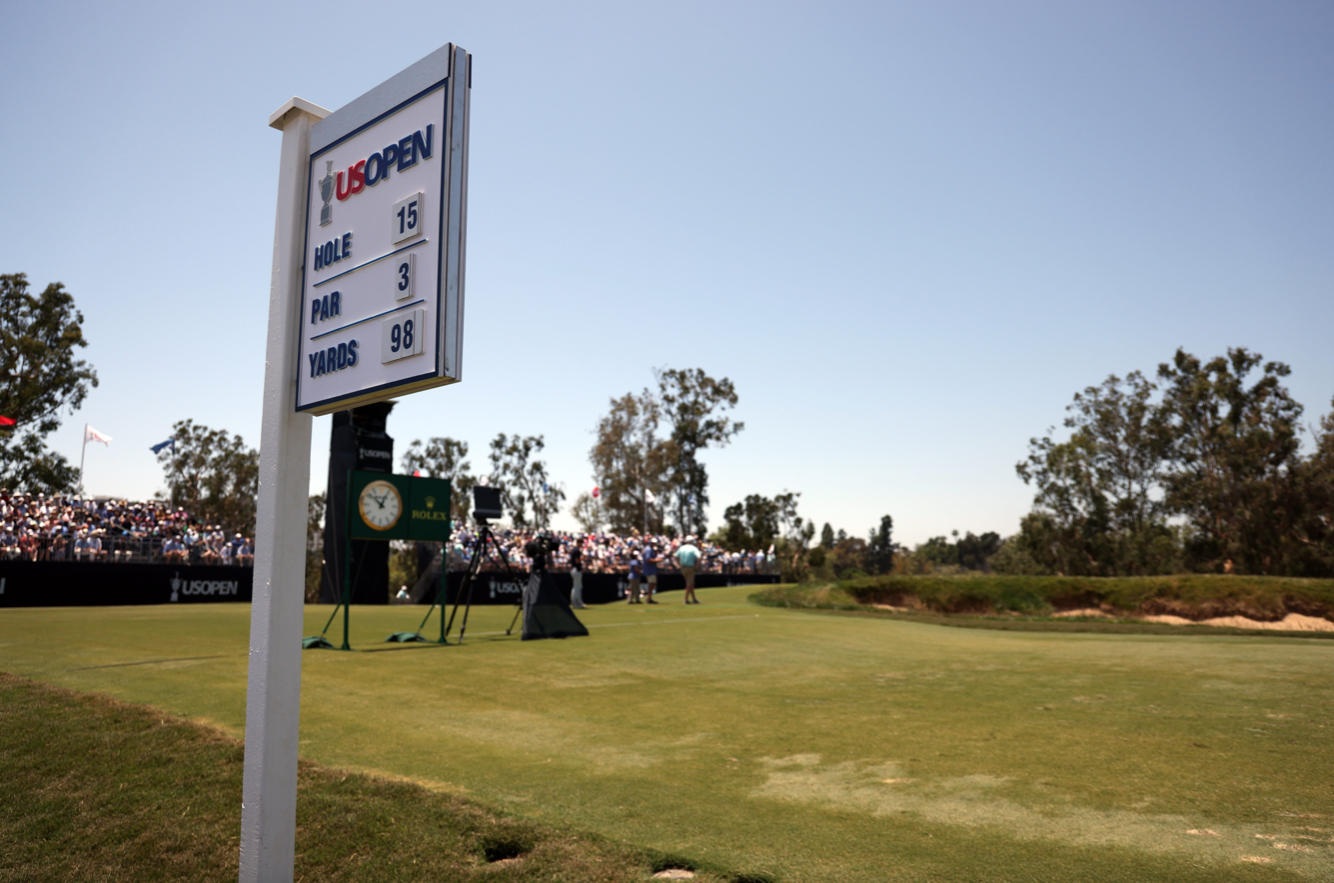LOS ANGELES — Golf is supposed to get easier the closer you get, right? After all, any weekend warrior would much rather be staring down a flag 81 yards away than 100 or 120 yards.
But golf can be vexing and frustrating, which is why when you ask most of the 65 golfers who made the cut at the U.S. Open, they would much rather be shooting at Thursday’s or Friday’s pin on the 15th hole, which played 124 and 115 yards, than the challenge they faced on Saturday.
From just 81 yards.
“Just get it on the green,” was Jon Rahm’s strategy.
“Definitely a funky shot,” Cameron Young said. “Not one you see very often.”
The hole is the shortest in U.S. Open history, 11 yards closer than the seventh hole during the final round of the 2010 U.S. Open at Pebble Beach.
To think of it another way, all but two holes from the blue tees at Palm Beach Par 3 are longer than what the most skilled golfers on the planet played Saturday at the LA Country Club.
U.S. OPEN: Leaderboard | How to watch
And this is the hole on which three holes-in-one occurred in the first two rounds. Matthieu Pavon and Sam Burns on Thursday and Matthew Fitzpatrick on Friday.
Those pins were on either side of a hump that sits in the middle of the green. The play was to spin it back.
The shortest hole in @USOpenGolf HISTORY.@GallagherJrGC and @NickDougherty5 explore the par-3 15th that’s playing at 81 (!) yards on Saturday.
: @NBC & @peacock | #USOpen pic.twitter.com/7oAwVoPO3M
— Golf Channel (@GolfChannel) June 17, 2023
Saturday’s pin was about 15 yards in front of that hump in a tight spot; about 18 feet from the fringe on the left, 15 feet from the right and 18 feet from the front fringe that runs downhill. And it sat on a slight left-to-right slope.
“You need a lot of luck today,” Shane Lowry said about adding to the hole-in-one count on No. 15 Saturday. “The first two days you could hit a good shot and a couple of different options of making it. Today you need to hit a perfect shot and get lucky.”
Bunkers, surrounded by thick rough, protect the green on each side, the one on the left curling around toward the front.
If you hit it short left like Ryan Fox, the first golfer to play the hole Saturday, did, it catches the bunker. If you hit it short right it will roll back off the green. To the right of the pin, more trouble.
The safe play Saturday was aiming beyond the flag, catching the slope and spinning it back. The high-risk, high-reward play is aiming a few feet back and spinning it back. But not quite as much.
But all that means spinning a lob wedge. And spinning a lob wedge isn’t easy. So I am told.
“If I hit 10 balls, I would probably hit the green once if you’re going at the flag because it’s such a small portion and the green’s so firm,” said Shane Lowry, who parred the hole after hitting it 25 feet past on his tee shot.
Adam Hadwin’s ball stopped 27 feet past the pin.
And he was good with that.
“More than anything, I’m just trying to get it on the green,” said Hadwin, who carded a par. “Just give yourself a chance.”
Brooks Koepka got it on the green Saturday, but he didn’t give himself a chance. He was 61 feet past the hole and faced a lot of angles leading back to the pin. His adventure ended with a double bogey after four putts.
Koepka on Friday gave us his reasons why he does not like the course. Now, he can add another to the list.
Padraig Harrington wondered what all this fuss is about. The Irishman pulled out a 64-degree wedge, landed the ball just a few feet past the pin, watched it take a bounce and then spin back to 5 ½ feet from the hole.
He knocked in the birdie putt on his way to shooting a 67.
“There’s a slope just left of the pin,” Harrington said. “If you can bang it into that left, as long as you’re four, five yards left of the pin there’s a nice up-slope.”
Where Harrington didn’t agree with his peers was the pin placement. He preferred Saturday’s tight pin placement over the pins in the first two rounds.
“I would say it’s a generous pin,” he said. “A little bit awkward because we’re not used to such a short shot on a par 3.
“I actually thought that was easier than the two around the hump because you get wrong side of the hump you’re …. ”
Part of what makes this course so unique is the setup. The 15th hole, the shortest on the course, follows the longest hole on the course. No. 14 was at 627 yards Saturday.
And about 20 yards off the back of the 15th green are two tee boxes, one for the 11th hole, which is one of the longest par 3s in U.S. Open history.
No. 11 played at 297 yards Friday.
Two par 3s. One requiring a lob wedge off the tee, the other a 3-wood.
“You’re going to watch professional golfers use some creativity,” Max Homa said. “And that’s definitely one trick that is quite useful.”

